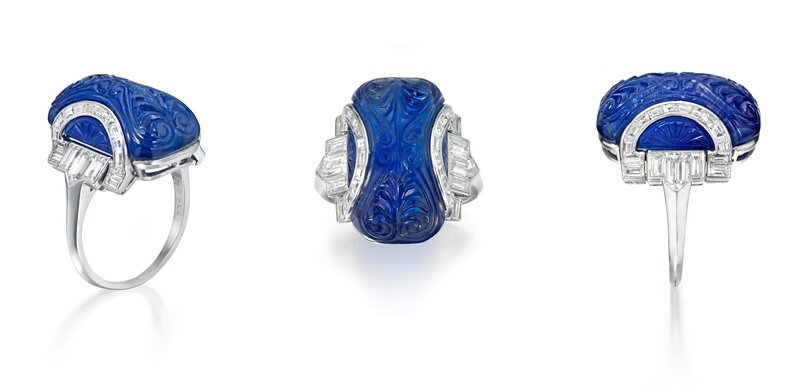Art Deco Mughal Burmese Sapphire and Diamond Ring, circa 1925
Art Deco Mughal Burmese Sapphire and Diamond Ring, circa 1925. Sapphire, diamond, platinum, 2.8 x 2.2 x 1.9 cm (1.1 x .9 x .75 in.). Image courtesy Siegelson / Stand 360, TEFAF New York Fall 2018.
In the 1920s, far off lands such as India, China, and Egypt became sources of inspiration for jewelers who borrowed from the decorative themes of foreign art and architecture. The ideal Art Deco jewels incorporated these exotic forms with a bold use of symmetry, geometry and color. This ring showcases both an exotic stone and a bold geometric mounting.
The Burmese sapphire centering this ring was discovered in the Mogok Valley, then undoubtedly carved in India. The particular leaf form is an important artistic motif dating back at least to ancient Egypt and celebrated by the Greeks and Romans. Known as a palmette, it is a symmetrical grouping of fronds spreading from a single base incorporating volutes. While the design evokes the palm leaf, it is also representative of the tree of life, the archetype of the sacred tree that appears across many world religions. It is essentially a view of a verdant paradise garden representing the lifecycle of all living things. The palmette appears in many important architectural sites dating back thousands of years, particularly in decorative borders. An unusual geometric mounting supports the magnificent stone, with diamond-set curves running through carved channels in the stone.
In the 1920s, jewelers such as Cartier and Van, Cleef & Arpels created pieces incorporating carved Mughal stones for the wealthiest and most knowledgeable connoisseurs of art including J. P. Morgan, the Aga Khan, and Baron Eugène de Rothschild. The stones were difficult to acquire and so relatively few pieces were made, making them more rare and desirable. Capturing the essence of India with a Mughal sapphire, while incorporating the bold aesthetic of the Art Deco movement, this ring is a stunning and covetable jewel.
Siegelson. 589 5th Avenue Suite 1501 New York, NY 10017 United States of America (212) 832-2666 See map Visit website

/https%3A%2F%2Fprofilepics.canalblog.com%2Fprofilepics%2F1%2F0%2F100183.jpg)
/https%3A%2F%2Fstorage.canalblog.com%2F03%2F02%2F119589%2F96711876_o.jpg)
/https%3A%2F%2Fstorage.canalblog.com%2F11%2F31%2F119589%2F94773502_o.jpg)
/https%3A%2F%2Fstorage.canalblog.com%2F20%2F83%2F119589%2F94772815_o.jpg)
/https%3A%2F%2Fstorage.canalblog.com%2F26%2F72%2F119589%2F75604929_o.jpg)
/https%3A%2F%2Fstorage.canalblog.com%2F59%2F60%2F119589%2F26458628_o.jpg)




/image%2F1371349%2F20240312%2Fob_5c4aff_431191724-1632300367539976-44512089002.jpg)
/http%3A%2F%2Fstorage.canalblog.com%2F97%2F56%2F119589%2F128916436_o.jpg)
/http%3A%2F%2Fstorage.canalblog.com%2F97%2F36%2F119589%2F128062654_o.png)
/http%3A%2F%2Fstorage.canalblog.com%2F59%2F40%2F119589%2F122159287_o.jpg)